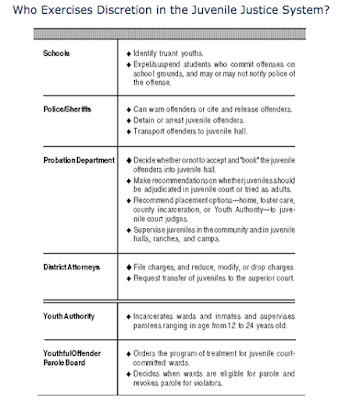 |
| Source: Legislative Analyst’s Office |
SB 382, coauthored by Senators Ricardo Lara and Mark Leno, clarifies the criteria under which the criminal justice system should determine whether to try a juvenile as an adult.
This summary by the Legislative Analyst’s Office provides a good guideline to the way discretion is applied in processing juveniles. Some serious offenses trigger a prosecutorial prerogative of “direct filing”, that is, charging and trying a juvenile’s case in adult court. Alternatively, the D.A. can ask for a “fitness hearing”at the juvenile court, which includes a report by a probation officer and a judicial decision whether to transfer the case.
The newly passed bill enumerates the five criteria to be taken into account when making the call whether to try juveniles in juvenile or adult court, which are as follows:
(A) The degree of criminal sophistication exhibited by the person. This may include, but is not limited to, giving weight to the person’s age, maturity, intellectual capacity, and physical, mental, and emotional health at the time of the offense, the person’s impetuosity or failure to appreciate risks and consequences of criminal behavior, the effect of familial, adult, or peer pressure on the person’s actions, and the effect of the person’s family and community environment and childhood trauma on the person’s criminal sophistication.
(B) Whether the person can be rehabilitated prior to the expiration of the juvenile court’s jurisdiction. This may include, but is not limited to, giving weight to the minor’s potential to grow and mature.
(C) The person’s previous delinquent history. This may include, but is not limited to, giving weight to the seriousness of the person’s previous delinquent history and the effect of the person’s family and community environment and childhood trauma on the person’s previous delinquent behavior.
(D) Success of previous attempts by the juvenile court to rehabilitate the person. This may include, but is not limited to, giving weight to an analysis of the adequacy of the services previously provided to address the person’s needs.
(E) The circumstances and gravity of the offense for which the person has been convicted. This may include, but is not limited to, giving weight to the actual behavior of the person, the mental state of the person, the person’s degree of involvement in the crime, the level of harm actually caused by the person, and the person’s mental and emotional development.
We will be following juvenile matters more closely in the coming weeks, in preparation for a special event: the Hastings Institute for Criminal Justice, with the collaboration and cosponsorship of Rosen, Bien, Galvan & Grunfeld, LLP, will be holding a special screening and discussion of Caitlin McNally’s film Stick Up Kid, which follows Alonza Thomas as he is prosecuted and punished as an adult. McNally will be with us, as well as a lawyer and a student who were formerly tried and incarcerated as juveniles and two advocates for juvenile justice. Save the date – 9/17 – and stay tuned for more.




No comment yet, add your voice below!